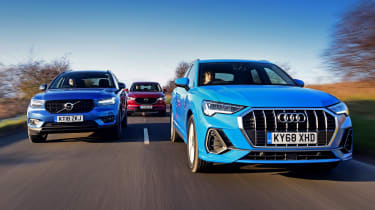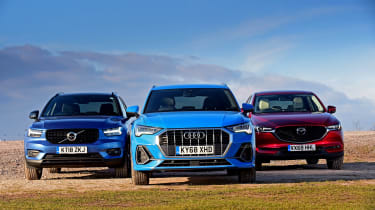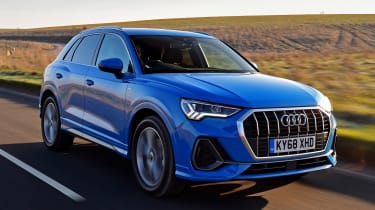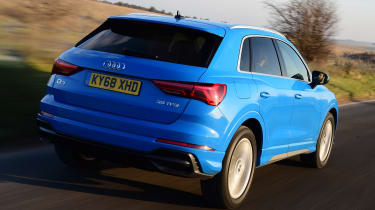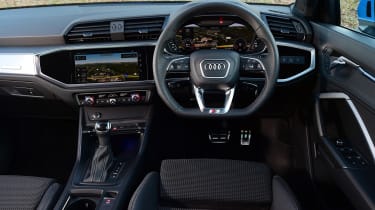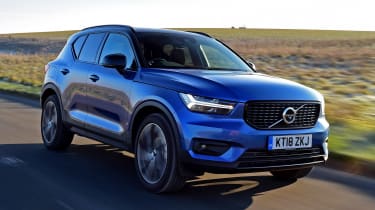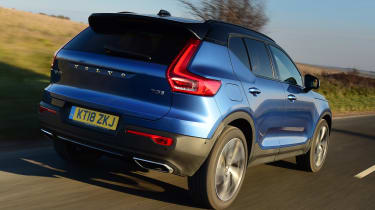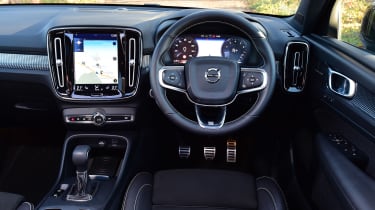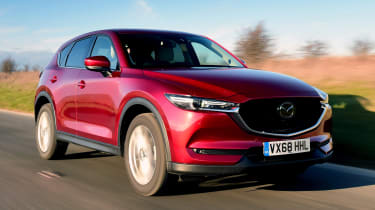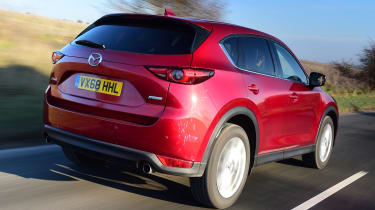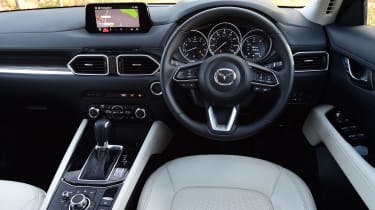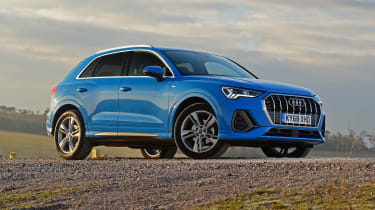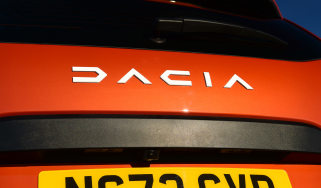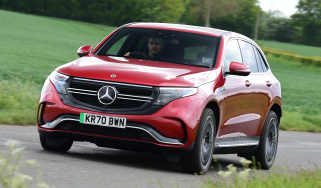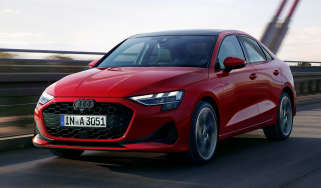Audi Q3 vs Volvo XC40 vs Mazda CX-5
The original Audi Q3 set the premium crossover blueprint. We see if the new car is a class leader as it faces the Volvo XC40 and Mazda CX-5
The Q3 was one of the first small upmarket SUVs and it proved an enormous success for Audi. Over the original model’s seven-year lifespan the company shifted 100,000 examples in the UK.
It’s been the template for the small premium crossover, but in recent years there’s been a glut of new rivals trying to ape the Audi’s success, and a legion of more mainstream models has tried to push upmarket and encroach on the Q3’s territory.
None of them is newer than the Volvo XC40. In fact, this is our favourite small premium SUV on sale, so if the Q3 wants to follow in the footsteps of its forebear, this is the car it has to overcome.
Audi is also facing pressure from below, because the Mazda CX-5 has been refreshed for its 2019 model year with a new trim line-up that’s more premium than ever. Look at this car next to the Q3 and you’ll see that these two vehicles are incredibly close when it comes to boot space, power, performance and price – plus the level of equipment on offer.
• Best crossovers and small SUVs
This will be a stern test for the Q3, with pressure being applied to it on all fronts, but if it’s anything like Audi’s recent efforts with its new models – including the A8, A7 and A6 – it will be a talented car. Is this enough to take victory, though? Read on to find out.
Audi Q3
| Model: | Audi Q3 35 TFSI S tronic S line |
| Price: | £34,150 |
| Engine: | 1.5-litre 4cyl turbo, 148bhp |
| 0-60mph: | 9.0 seconds |
| Test economy: | 31.7mpg/7.0mpl |
| CO2: | 133g/km |
| Annual road tax: | £140 |
Audi has updated its Q3 with a fresh chassis and tech, and we’re testing it in 35 TFSI S line guise. Initially, all cars will get the S tronic dual-clutch auto (from £34,150), but a manual is available to order.
Design & engineering
As with so many front-engined, front-wheel-drive models in the VW Group stable, the latest Audi Q3 is based on its parent firm’s MQB architecture, which is a versatile modular matrix that’s scalable. Here, it’s just under 4.5 metres in length and just over 1.8 metres wide, which puts the SUV on par for its physical footprint with the two rivals it’s going up against.
More reviews
Car group tests
- BMW X1 vs Audi Q3: 2022 twin test review
- Audi Q3 Sportback vs Lexus UX
- Audi Q3 vs Range Rover Evoque vs Volvo XC40
In-depth reviews
Road tests
Used car tests
Just as with the chassis, the 1.5-litre four-cylinder turbo petrol engine is familiar. In 35 TFSI guise (the name refers to its power output in kW, not engine size) it produces 148bhp and 250Nm of torque here and sends that power to the front wheels only through a seven-speed dual-clutch gearbox.
This transmission will make up the wave of early deliveries, while a six-speed manual and quattro four-wheel drive will follow later. Going for the manual gearbox will save you £1,580 and put the Q3 closer to the manual-only XC40 T3 R-Design.
Although it’s pricier, it feels good for the money, because the quality inside is of the typically high standard we’ve come to expect from an Audi interior, even if there are some areas where pennies have been pinched. Still, it’s no worse than in the XC40 and in the most part the plastics are premium, while the mix of textures and materials creates the right feel, and the technology is superb.
S line spec offers parking sensors, climate and cruise control, Apple CarPlay, Android Auto, sat-nav, a digital dash, a power tailgate and half-leather seats – plus some great standard safety tech. In fact, the included kit list is so comprehensive that wireless charging (£150) and a reversing camera (£395) are the only extras truly worth considering.
Driving
The Q3’s engine is better exploited in the mid range rather than revved right out, because it feels punchier and keener to deliver its performance. The in-gear tests showed the Audi’s advantage, where it edged the Volvo from 50 to 70mph in sixth, taking 10.1 seconds compared with 12.7 seconds in the Swedish model. The XC40 only matched the Audi in third gear between 30 and 50mph, taking 3.9 seconds.
With launch control and swift shifts thanks to its dual-clutch gearbox, the Q3 was the fastest car on test from 0-60mph, taking 9.0 seconds. The gearbox slurs changes well to keep things smooth, while taking manual control delivers snappy shifts.
Rev the engine and it sounds strained, but it is refined enough thanks to the mid-range torque, so you don’t have to work it as hard as the Mazda.
The ride and therefore comfort is acceptable, too, thanks to the standard passive dampers’ ability to mostly smooth out the impact of all but the worst bumps. These do cause a jiggle, but the set-up tones this down well so it still rides with a decent level of maturity. This doesn’t come at the expense of agility, though, because the Q3’s steering is light but quick and accurate; it’s the roll that creeps into the driving experience that limits the dynamic ability here. Still, even for an SUV direction changes are positive and the Q3 offers a good trade-off between ride quality, refinement, handling and comfort.
Practicality
The Q3 has grown in size. By the end of its predecessor’s lifespan boot space was an issue, but not here. With a 530-litre load bay, it’s the largest of the three cars for luggage room; this increases to 675 litres if you move the split sliding bench seat forward, giving the Q3 an advantage.
Fold the seats down and with 1,525 litres it has the edge over the Volvo, even if the Mazda is larger, at 1,620 litres. Enlarging the Q3’s size means Audi has also made it bigger inside. In the rear it’s noticeably roomier, and also more spacious than the XC40 and about equal to the Mazda.
Packaging is much improved and it feels more spacious up front, too. Visibility is great (better than in the Volvo) and that reassuringly commanding driving position is still present, only storage and ergonomics are better. It’s a match for the XC40 and feels more versatile than the CX-5 for spaces for odds and ends.
Ownership
Audi was 18th out of 26 brands in our Driver Power 2018 survey and lost out to Volvo (13th) and Mazda (9th). Autonomous braking with pedestrian detection is standard, as are lane departure warning and lane-keep assist.
You can add semi-autonomous adaptive cruise, emergency assist, high beam assist and traffic sign recognition as part of the £800 Driver Assistance Pack and cross-traffic assist as part of the £995 Comfort and Sound Pack.
The Q3 scored a maximum five-star Euro NCAP safety rating when it was tested recently.
Running costs
These models are often bought by business users, so company car tax will be important. The Audi emits less CO2 than its rivals, at 133g/km, so it sits in the 27 per cent Benefit-in-Kind bracket. The XC40 emits 144g/km of CO2 and is in the 29 per cent BiK band, while the 150g/km Mazda is two percentage points above that.
Despite the Q3’s low emissions outputs, its higher price means it’ll cost higher-rate earners more in company car tax contributions than the XC40, at £3,660 compared with £3,468. And while the Mazda is the cheapest choice, its more polluting non-turbo engine translates to company car tax of £3,824 a year.
Testers’ notes: “The Audi’s boot floor can be adjusted in three stages, while there’s space underneath it to stow the parcel shelf if you need to use the Q3 for its maximum carrying capacity.”
Volvo XC40
| Model: | Volvo XC40 T3 R-Design |
| Price: | £30,160 |
| Engine: | 1.5-litre 3cyl turbo, 154bhp |
| 0-60mph: | 10.6 seconds |
| Test economy: | 30.1mpg/6.8mpl |
| CO2: | 144g/km |
| Annual road tax: | £140 |
The XC40 is our favourite compact premium SUV. It arrived in the UK last year and shot straight to the top of the class, but the pace of the market means it’s now no longer the new kid on the block. We’re testing it here in T3 R-Design form (our images show an R-Design Pro), which costs £30,160.
Design & engineering
The XC40 is cheaper than the Q3 because this T3 turbo petrol engine is only available with a manual transmission, unlike the Audi or the Mazda. The engine displaces 1.5 litres, the same as the Audi, but unlike the Q3, the Volvo is a three-cylinder. That motor kicks out 154bhp and 265Nm of torque – more than the Q3 – yet the car is only 2kg heavier, at a claimed 1,497kg.
The six-speed manual box sends drive to the front wheels, and while four-wheel drive is available on the T4 and T5 petrols, this T3 is two-wheel drive only. The transmission makes up a good portion of the price difference, but the manual Q3 is still £2,410 more expensive. We feel some of that is down to the Audi’s longer list of standard equipment.
In R-Design trim the Volvo features sat-nav, a digital dash, autonomous braking, parking sensors and LED lights, plus half-leather seats to match its rival. A reversing camera is a £375 option and some of the more advanced safety tech is extra, too, plus heated seats are part of a £500 pack. A power tailgate costs £375 but is standard on the Q3. The item that really stands out, though, is the XC40’s connectivity: CarPlay and Android Auto are part of a £300 pack when the Audi gets these features as standard.
At least quality is strong – not quite a match for the Q3, but the materials feel like they justify the price tag and edge out the Mazda. The cabin design is the most interesting, but also still functional.
This practicality is helped by the platform, because the XC40 sits on Volvo’s CMA Compact Modular Architecture. Like the Q3’s MQB set-up, this is a scalable chassis that uses MacPherson-strut front suspension and a multi-link layout at the rear.
Driving
The XC40 is the best-riding car here, with a more gentle approach to its suspension damping than the Audi, which means it feels more settled at speed.
However, while it replicates this on country roads, it doesn’t feel as controlled or as composed as the Q3. The steering is light but quick and you get a sense of the Volvo’s taller stance. It doesn’t inspire as much confidence as the Audi, because even though that car feels just a touch more rigid in the way the dampers deal with bumps, it also has more precision, greater agility and therefore gives you more reassurance.
It’s true that more buyers in this class will look for comfort rather than how much speed you can carry, and here the XC40 balances these traits nicely.
Although the engine is more potent than the Audi’s on paper, the Volvo’s 1.5-litre three-cylinder turbo unit can’t match the four-cylinder 1.5 Audi.
It was 1.6 seconds slower from 0-60mph, taking 10.6 seconds, which was partly due to the fact this T3 only comes with a six-speed manual box. The shift is sweet enough; it’s nothing to write home about, but it doesn’t detract from the driving experience. The XC40 couldn’t match the Audi in gear, either, despite its 15Nm torque advantage. Refinement is still good because the triple doesn’t grumble like some. It only becomes more vocal at higher revs. But it remains smooth. That’s the XC40’s main trait: smoothness and refinement in almost every area.
Practicality
The XC40’s boot isn’t as big as its rivals’ here. There’s 460 litres with the rear seats in place and 1,336 litres when they’re folded down. While it does limit its practicality compared with the Q3 when you’re really after space, in most day-to-day situations owners will find the XC40’s boot adequate, just like they will the cabin.
If the Audi’s interior is a tech-laden example of quality, the Volvo’s feels warmer and more welcoming, if not quite as advanced. There’s still plenty of technology, but the materials give it a more vibrant feel – and there’s space to match.
It might not be as large in the rear as the Audi, but the tall roofline and upright seats mean there’s plenty of head and legroom.
Storage is acceptable, too. It feels spacious, and allied to the comfort, it means even long journeys in the XC40 aren’t too much of a chore.
Ownership
Volvo’s 13th place result in our Driver Power 2018 poll edged it ahead of Audi, with its second place in the safety category a particular highlight. That’s unsurprising given the brand’s reputation and the fact that the XC40 scored a full five-star Euro NCAP rating.
Autonomous braking with pedestrian detection and lane-keep assist are standard, as are seven airbags and oncoming lane mitigation (a system that helps you swerve to avoid oncoming traffic).If you want blind spot warning, cross-traffic alert and autonomous braking for when you’re in reverse, the IntelliSafe Surround pack costs £600.
Running costs
The premium brand is a big draw for second-hand buyers, so after three years/36,000 miles our experts predict the Q3 should be worth £16,652, a retained value of 48.8 per cent. The Volvo should hold on to 52.9 per cent, which means it’ll be worth £15,946 after the same period because it’s cheaper to buy.
Our experts rate this spec of CX-5 as retaining 46.5 per cent of its list price, or £14,075. That means it’ll depreciate by £16,220 over the same period.
Testers’ notes: “The XC40’s real appeal lies in its individuality. The styling and interior capture the essence of a modern Volvo, although we’d go for a less sombre spec than this all-black cabin.”
Mazda CX-5
| Model: | Mazda CX-5 2.0 SkyActiv-G 2WD auto Sport Nav+ |
| Price: | £30,295 |
| Engine: | 2.0-litre 4cyl, 163bhp |
| 0-60mph: | 9.2 seconds |
| Test economy: | 34.5mpg/7.6mpl |
| CO2: | 150g/km |
| Annual road tax: | £140 |
A range refresh last year, with new, higher-spec trim levels and added appeal has pushed the Mazda CX-5 even further upmarket and closer to the likes of Audi’s new Q3. We’re testing it in £30,295 2.0 SkyActiv-G auto Sport Nav+ form.
Design & engineering
Thanks to its subtle but significant updates, including this new Sport Nav+ trim level – and a GT Sport Nav+ model – the Mazda is continuing its push upmarket, encroaching on the likes of the Audi’s territory. That means the Q3 faces pressure from conventional foes, but also from below as more makers want a slice of the premium pie.
The CX-5 is still based on Mazda’s SkyActiv vehicle architecture, which uses lightweight materials in places to keep mass down and boost efficiency and performance without hampering safety.
At 1,560kg, it’s only slightly heavier than the 1,497kg Volvo; the Audi is 2kg lighter again.
Mazda’s chassis set-up is known for producing great results when it comes to agility, though, so the CX-5 should shrug off its extra weight.
It’s as much about image and equipment as it is about dynamic ability in this class, though, and it’s here, with its new trim structure, that the CX-5 makes big strides forward.
While badge prestige might still not match the Audi, there’s at least as much standard kit. Parking sensors, a reversing camera and lots of safety features – including autonomous braking, adaptive cruise and LED lights – heated leather seats, keyless operation, a power tailgate and sat-nav are all included. CarPlay and Android Auto are really the only options you might want to consider; they’re part of a £350 pack.
Even though the CX-5 costs less than the Audi, the quality of materials is good. It doesn’t feel quite as upmarket, but then it’s not quite as expensive. The biggest deficiency compared with its competitors here is the tech, though. A lack of sharp-resolution graphics and a digital dash hasn’t been a huge issue in the past, but against rivals that boast these qualities as standard, it could make the difference to buyers.
Driving
The CX-5 still drives as well as ever, even when fitted with the naturally aspirated 2.0-litre four-cylinder non-turbo petrol we’re testing. Unlike its downsized turbocharged rivals, Mazda’s right-sized policy means this larger lump produces more power, at 163bhp, but with only 213Nm it is down on torque compared with its competitors.
You feel this latter figure on the road and it also showed during our performance tests because the CX-5 was slower than its opponents here.
As it doesn’t have a turbo to boost its mid-range and the Mazda has only six gears to the Q3’s seven, it took 23.3 seconds to accelerate from 50 to 70mph in sixth, whereas the Audi managed 10.1 seconds.
The Q3 was more urgent from 30-50mph in the lower gears as well. It needed just 5.2 seconds in fourth, whereas its turbocharged Volvo rival took a second longer in fifth. The Mazda took 7.6 seconds.
However, using the upper reaches of the rev range from 0-60mph, where the CX-5’s performance lies, highlighted that it was only two tenths slower than the Q3, taking 9.2 seconds. This shows that refinement isn’t the Mazda’s strongest point, because with no turbo boosting its mid-range performance, you have to rev it to extract the pace.
The six-speed auto box also holds on to ratios too long and is sluggish to shift when it does, so it doesn’t feel as instant or as punchy as either rival, despite its higher power output. In fact, it feels laboured.
Still, the CX-5’s chassis is great. It doesn’t have the body control of the Audi, but then it also isn’t as firm and rides with more compliance. It still governs its mass well, so the chassis doesn’t wallow around.
In fact, it’s a good balance of agility and comfort. The steering has a great weight and a good speed; it’s not overly assisted and doesn’t have the artificial-feeling enhanced responsiveness to inputs of its rivals. It feels more natural as a result.
Practicality
The CX-5’s footprint is actually similar to its rivals’ here, while it trumps the XC40 for boot space, at 506 litres. This is 24 litres down on the Q3, but in reality this isn’t too much and the Mazda should offer enough practicality for most situations.
There’s not much to split the CX-5 and Q3 for rear legroom, but the Audi’s cabin feels more spacious in the front with better storage, even if the driving position and range of adjustment isn’t as good.
Levers in the load bay make it easy to fold the rear seats from the boot as well.
Ownership
Mazda’s ninth place result in our Driver Power 2018 survey was a strong showing, with the brand praised for its ride and handling, as well as reliability and build quality.
We don’t disagree, but you can also add safety to that list as well, because the five-star-rated CX-5 offers autonomous braking, blind spot monitoring, lane-keep assist and cross-traffic alert.
Running costs
Despite lacking a turbo, the CX-5 returned stronger economy on test of 34.5mpg, which means annual fuel bills of £1,935 over 12,000 miles. This compares with the XC40’s 30.1mpg, which means you’ll only pay £2,218 a year at the pumps. No surprise, given it’s a manual.
The Q3 returned a respectable 31.7mpg, which means your outgoings on petrol will come to £2,106 over 12 months; the Audi and Volvo were closer, but running costs here are still similar.
Testers’ notes: “If towing a trailer is important to you, the Mazda’s 2,000kg limit is good. That figure beats both its rivals’, because the Q3 can pull a maximum of 1,800kg, while the Volvo trails this, on 1,600kg.”
Verdict
First place: Audi Q3
The Q3 has come of age. It’s a more mature, more refined and more practical package than before, and is loaded with lots of desirable technology as standard. This makes it really easy to live with, along with its great flexibility. Yet it hasn’t lost its premium appeal or character. The Audi is pricier, but the quality and kit compared with the Volvo mean we feel it’s worth the extra.
Second place: Volvo XC40
While the XC40 is still a great compact premium crossover, it’s better in diesel auto form than this T3 petrol version. The lack of an automatic option hampers its appeal, and the engine isn’t as sweet as the Audi’s, either. Also, the infotainment isn’t as advanced (smartphone tech is optional), and while it’s comfortable and refined, the Audi’s extra practicality edges it ahead.
Third place: Mazda CX-5
The CX-5 has come a long way and is more premium than ever, but it still has a little way to go in this company. It beats the Volvo for practicality, but the Mazda’s infotainment is lacking, even after a significant update with CarPlay and Android Auto. The engine also feels a generation behind and means it’ll be pricier to run compared with its rivals.
Figures
| Audi Q3 35 TFSI S tronic S line | Volvo XC40 T3 R-Design | Mazda CX-5 2.0 SkyActiv-G 2WD auto Sport Nav+ | |
| On the road price/total as tested | £34,150/£37,565 | £30,160/£30,160 | £30,295/£34,690 |
| Residual value (after 3yrs/36,000) | £16,652/48.8% | £15,946/52.9% | £14,075/46.5% |
| Depreciation | £17,498 | £14,214 | £16,220 |
| Annual tax liability std/higher rate | £1,830/£3,660 | £1,734/£3,468 | £1,912/£3,823 |
| Annual fuel cost (12k/20k miles) | £2,106/£3,511 | £2,218/£3,697 | £1,935/£3,226 |
| Insurance group/quote/VED | 27/£525/£140 | 22/£411/£140 | 16/£384/£140 |
| Cost of 1st/2nd/3rd service | £170/£338/£170 | £300/£475/£300 | N/A |
| Length/wheelbase | 4,484/2,680mm | 4,425/2,702mm | 4,550/2,700mm |
| Height/width | 1,616/1,849mm | 1,658/1,910mm | 1,680/1,840mm |
| Engine | 4cyl in-line/1,498cc | 3cyl in-line/1,477cc | 4cyl in-line/1,998cc |
| Peak power/revs | 148/5,000 bhp/rpm | 154/5,000 bhp/rpm | 163/6,000 bhp/rpm |
| Peak torque/revs | 250/1,500 Nm/rpm | 265/1,850 Nm/rpm | 213/4,000 Nm/rpm |
| Transmission | 7-speed DSG/fwd | 6-speed man/fwd | 6-speed auto/fwd |
| Fuel tank capacity/spare wheel | 58 litres/£150 | 54 litres/£150 | 56 litres/repair kit |
| Boot capacity (seats up/down) | 530-675/1,525 litres | 460/1,336 litres | 506/1,620 litres |
| Kerbweight/payload/towing weight | 1,495/575/1,800kg | 1,497/492/1,600kg | 1,560/475/2,000kg |
| Turning circle/drag coefficient | 11.8 metres/0.32Cd | 11.8 metres/N/A | 12.0 metres/N/A |
| Basic warranty (miles)/recovery | 3yrs (60,000)/3yrs | 3yrs (60,000)/3yrs | 3yrs (60,000)/3yrs |
| Driver Power manufacturer/dealer pos. | 18th/22nd | 13th/9th | 9th/24th |
| NCAP: Adult/child/ped./assist/stars | 95/86/76/85/5 (2018) | 97/87/71/76/5 (2018) | 95/80/78/59/5 (2017) |
| 0-60/30-70mph | 9.0/8.5 secs | 10.6/8.8 secs | 9.2/8.8 secs |
| 30-50mph in 3rd/4th | 3.9/5.2 secs | 3.9/6.1 secs | 5.2/7.6 secs |
| 50-70mph in 5th/6th/7th/8th | 7.7/10.1/14.8 secs | 9.6/12.7 secs/N/A | 16.2/23.3 secs/N/A |
| Top speed/rpm at 70mph | 128mph/2,100rpm | 124mph/2,200rpm | 119mph/2,200rpm |
| Braking 70-0/60-0/30-0mph | 47.0/34.8/8.6m | 48.3/34.2/10.1m | 45.2/32.9/10.7m |
| Noise outside/idle/30/70mph | 70/42//62/72dB | 69/43/67/71dB | 68/43/64/72dB |
| Auto Express econ. (mpg/mpl)/range | 31.7/7.0/404 miles | 30.1/6.8/358 miles | 34.5/7.6/425 miles |
| Govt urban/extra-urban/combined | 41.5/54.3/48.7mpg | 37.2/52.3/45.6mpg | 36.2/47.9/42.8mpg |
| Govt urban/extra-urban/combined | 9.1/11.9/10.7mpl | 8.2/11.5/10.0mpl | 8.0/10.5/9.4mpl |
| Actual/claimed CO2/tax bracket | 206/133g/km/27% | 217/144g/km/29% | 189/150g/km/31% |
| Airbags/Isofix/park sensors/camera | Six/yes/yes/£395 | Seven/yes/yes/£375 | Seven/yes/yes/yes |
| Auto box/lane keep/blind spot/AEB | Yes/yes/yes/yes | No/yes/£600*/yes | Yes/yes/yes/yes |
| Clim/cruise ctrl/leather/heated seats | Yes/yes/half/£300 | Yes/yes/half/£500* | Yes/adaptive/yes/yes |
| Metallic/LEDs/keyless/power tailgate | £575/yes/£400/yes | £575/yes/£350/£375 | £560/yes/yes/yes |
| Nav/dig dash/DAB/connected services | Yes/yes/yes/yes | Yes/yes/yes/yes | Yes/no/yes/yes |
| Wireless charge/CarPlay/Android Auto | £150/yes/yes | £175/£300*/£300* | No/£350*/£350* |
